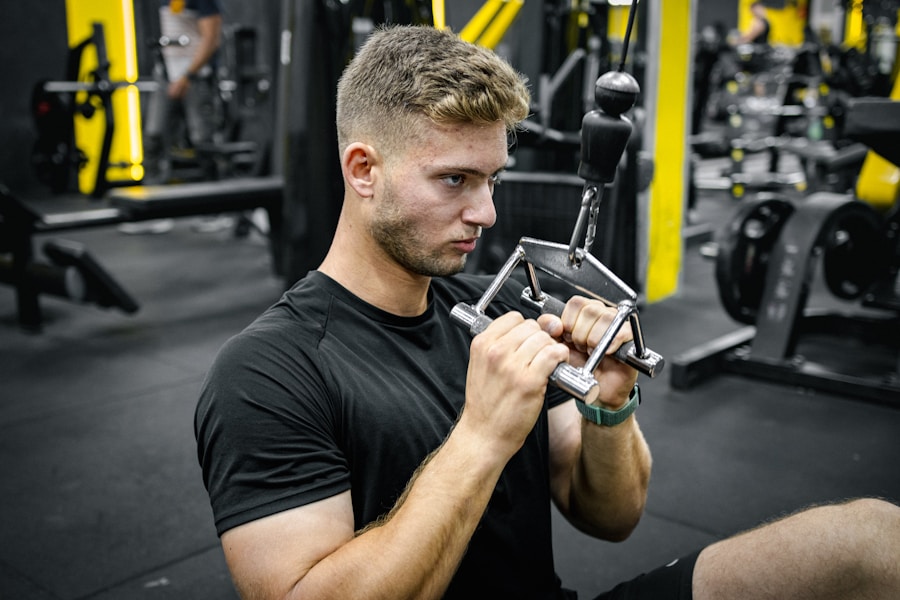The biceps brachii, commonly referred to as the biceps, is a prominent muscle located in the upper arm. It consists of two heads: the long head and the short head. The long head originates from the supraglenoid tubercle of the scapula, while the short head arises from the coracoid process of the scapula.
Both heads converge into a single muscle belly that attaches to the radial tuberosity of the radius bone in the forearm. This unique structure allows the biceps to play a crucial role in both elbow flexion and forearm supination, making it essential for various daily activities and athletic movements. Understanding the anatomy of the biceps is vital for anyone looking to enhance their training regimen.
The muscle’s dual-head structure means that different exercises can target each head to varying degrees. For instance, exercises that emphasize a wider grip tend to engage the long head more effectively, while narrower grips can focus on the short head. This knowledge allows individuals to tailor their workouts to achieve specific aesthetic or strength goals, ensuring a well-rounded development of this iconic muscle group.
Key Takeaways
- Understanding the anatomy of the biceps is crucial for targeting and building strong and defined muscles.
- Proper form and technique are essential for maximizing the effectiveness of bicep exercises and preventing injuries.
- Creating an effective bicep workout routine involves a combination of different exercises and training techniques.
- Nutrition plays a significant role in bicep development, and a balanced diet is essential for muscle growth and recovery.
- Incorporating progressive overload and understanding the benefits of isolation vs. compound exercises are key for bicep growth and strength.
The Best Bicep Exercises for Building Strength
When it comes to building strong biceps, several exercises stand out for their effectiveness. The classic bicep curl, whether performed with dumbbells, barbells, or cables, remains a staple in any bicep workout. This exercise primarily targets both heads of the biceps and can be modified in various ways to increase intensity or change the angle of resistance.
For example, incline dumbbell curls can place greater emphasis on the long head, while concentration curls isolate the short head for focused development. In addition to curls, chin-ups are an excellent compound exercise that engages the biceps significantly. By pulling oneself up with an underhand grip, chin-ups not only work the biceps but also engage other muscle groups such as the back and shoulders.
This multi-muscle engagement can lead to greater overall strength gains and functional fitness. Incorporating a variety of exercises into your routine ensures balanced development and helps prevent plateaus in progress.
The Importance of Proper Form and Technique
Proper form and technique are paramount when training biceps to maximize gains and minimize injury risk. Many individuals may be tempted to lift heavier weights without focusing on their form, which can lead to ineffective workouts and potential injuries. For instance, swinging weights during curls can shift the emphasis away from the biceps and onto other muscle groups, reducing the effectiveness of the exercise.
Maintaining a controlled motion throughout each repetition ensures that the biceps are fully engaged and worked through their complete range of motion. Additionally, understanding the importance of tempo can enhance bicep training results. A slower eccentric phase—where the weight is lowered—can create more muscle tension and promote hypertrophy.
By focusing on both lifting and lowering phases with proper form, individuals can achieve better muscle activation and growth. This attention to detail not only improves performance but also fosters a deeper connection with the muscles being trained.
How to Create an Effective Bicep Workout Routine
| Exercise | Sets | Reps | Rest |
|---|---|---|---|
| Barbell Bicep Curl | 3 | 8-10 | 60 seconds |
| Dumbbell Hammer Curl | 3 | 10-12 | 60 seconds |
| Preacher Curl | 3 | 8-10 | 60 seconds |
| Concentration Curl | 3 | 10-12 | 60 seconds |
Creating an effective bicep workout routine involves careful planning and consideration of various factors such as frequency, volume, and exercise selection. A well-rounded routine typically includes a mix of isolation and compound exercises to ensure comprehensive development. For example, one might start with heavy compound movements like chin-ups or bent-over rows before transitioning to isolation exercises like hammer curls or preacher curls for targeted work.
Frequency is another critical aspect; training biceps two to three times per week allows for adequate recovery while promoting growth. It is essential to vary rep ranges and weights used during these sessions to stimulate different muscle fibers. For instance, performing lower reps with heavier weights can build strength, while higher reps with lighter weights can enhance endurance and muscle definition.
Balancing these elements will lead to a more effective and sustainable bicep training program.
The Role of Nutrition in Bicep Development
Nutrition plays a crucial role in muscle development, including that of the biceps. Consuming an adequate amount of protein is essential for muscle repair and growth following workouts. Protein-rich foods such as chicken, fish, eggs, legumes, and dairy products should be staples in a diet aimed at building strength.
The general recommendation for those engaged in resistance training is to consume approximately 1.6 to 2.2 grams of protein per kilogram of body weight daily. In addition to protein, overall caloric intake must be considered. To support muscle growth, individuals often need to be in a slight caloric surplus, meaning they consume more calories than they burn.
This surplus provides the energy necessary for intense workouts and recovery processes. Furthermore, incorporating healthy fats and carbohydrates into one’s diet ensures that energy levels remain high during training sessions, allowing for optimal performance and recovery.
Tips for Avoiding Common Bicep Training Mistakes
Importance of Warming Up
Simple dynamic stretches or light cardio can effectively prepare the body for more strenuous activity. This initial step is often overlooked but plays a significant role in preventing injuries and ensuring a productive workout.
Overtraining and Its Consequences
Another common mistake is overtraining the biceps without allowing sufficient recovery time. While it may be tempting to train biceps frequently due to their smaller size compared to larger muscle groups, overworking them can lead to fatigue and diminished performance.
Recovery and Progress
It is crucial to listen to one’s body and incorporate rest days into training schedules. This approach not only aids recovery but also promotes long-term progress by preventing burnout, allowing the muscles to heal and grow stronger over time.
Incorporating Progressive Overload for Bicep Growth
Progressive overload is a fundamental principle in strength training that involves gradually increasing the demands placed on muscles over time. For bicep growth, this can be achieved by increasing weights, adjusting rep ranges, or altering exercise variations. For instance, if an individual can comfortably perform three sets of 10 reps with a certain weight, increasing that weight or adding an additional set can stimulate further growth.
Incorporating progressive overload not only enhances muscle size but also improves overall strength and endurance. It encourages continuous adaptation by challenging muscles beyond their current capabilities. Tracking progress through a workout log can help individuals identify when it’s time to increase intensity or change exercises, ensuring consistent advancement toward their fitness goals.
Both isolation and compound exercises have unique benefits when it comes to bicep training. Isolation exercises, such as dumbbell curls or cable curls, specifically target the biceps without engaging other muscle groups significantly. This focus allows for maximum contraction and tension on the biceps, which is essential for hypertrophy and definition.
On the other hand, compound exercises like chin-ups or bent-over rows engage multiple muscle groups simultaneously while still providing substantial work for the biceps. These movements not only promote overall strength but also improve functional fitness by mimicking real-life activities that require coordinated effort from various muscles. A balanced workout routine that incorporates both types of exercises will yield optimal results in both strength and aesthetics.
How to Prevent Bicep Injuries and Overtraining
Preventing injuries during bicep training requires attention to several key factors, including proper warm-up routines, appropriate weight selection, and listening to one’s body signals. Engaging in dynamic stretches before workouts prepares muscles for exertion while reducing injury risk. Additionally, using weights that allow for controlled movements rather than attempting to lift excessively heavy loads can help maintain proper form throughout exercises.
Overtraining is another concern that can lead to injuries or setbacks in progress. Signs of overtraining include persistent soreness, fatigue, decreased performance, and lack of motivation. To prevent this condition, it is essential to incorporate rest days into training schedules and vary workout intensity throughout the week.
By prioritizing recovery alongside training efforts, individuals can maintain consistent progress while minimizing injury risks.
The Top Bicep Training Myths Debunked
Several myths surrounding bicep training can mislead individuals seeking effective workouts. One common misconception is that performing countless repetitions will automatically lead to bigger biceps; however, muscle growth primarily occurs through progressive overload rather than sheer volume alone. Quality over quantity should be emphasized in training regimens.
Another prevalent myth is that isolation exercises are superior for building size compared to compound movements; while isolation exercises are effective for targeting specific muscles, compound exercises also contribute significantly to overall muscle development due to their engagement of multiple muscle groups. Understanding these myths allows individuals to approach their training with a more informed perspective, leading to better results in their quest for strong and defined biceps.




